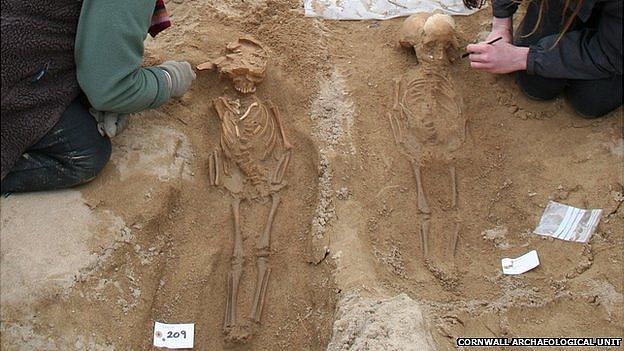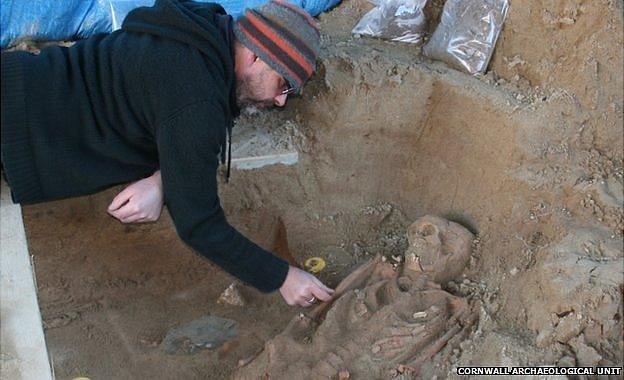Dark Age skeletons at St Piranʼs Oratory are 'significant find'
- Published

The bones of two skeletons showed familial traits and appeared to have been buried together, suggesting a close relationship
Skeletons uncovered at an historic site have been dated to the Dark Ages, in what is being called a "nationally significant discovery".
Archaeologists said the "amazing" finds at St Piran's Oratory in Cornwall are thought to confirm an early Christian presence there.
The surviving building is thought to date to the 11th or 12th Century.
Tests on the skeletons of two children, excavated last year, show they date from the 8th or 9th Century.
James Gossip, from Cornwall Archaeological Unit, which led the excavations, said the skeletons of two adults and 10 children had been found to the north-west of the Oratory, buried approximately 24in (60cm) down.

James Gossip said further analysis of the skeletons should provide details on origins, migration and diet

St Piran's Trust, set up in 2000, raises funds to excavate and interpret the church and the earlier Oratory of St Piran

The adult skeletons were female, one aged at least 45 and the other probably 20-25, while the children were aged one to five, with one aged under six months
He said: "The first sample, taken from the skeleton of a child buried on its side in a flexed position, produced a date suggesting burial in the 8th or 9th Centuries.
"The second, also a child, appears to have been buried around the same time, but more probably in the 9th Century.
"If this is the case then these burials relate to an earlier structure, the presence of which has long been suspected."

History of St Piran's Oratory
The 6th Century remains of St Piran's Oratory - at Penhale Sands, near Perranporth - are believed to be among the oldest places of Christian worship in Britain
According to legend, St Piran was born in Ireland in the 6th Century, but spent most of his life in Perranporth
St Piran is the patron saint of tin miners and his flag - a white cross on a black background - represents white tin flowing from black rock
Two major digs were carried out in 1835 and 1843
The remains were encased in a large concrete structure in 1910 after a number of skeletons - including one of a large headless man - were found
In 1980 the structure was removed and the site was buried in sand
St Piran's Trust was set up in 2000 to campaign for the ruins to be unearthed again and studied

Mr Gossip said: "Due to the scarcity of religious structures scientifically dated to the early medieval period these findings are of national significance and help to confirm the early medieval origins of a religious centre at the Oratory site."
Eileen Carter, a founder member of the St Piran Trust, which cares for the Oratory, said: "We are thrilled. These results are very important as they point to the existence of a place of Christian worship at this time."
Ian Saltern, also from the trust, said: "It is hoped that further archaeological work may reveal additional, perhaps earlier, burials."
Mr Gossip said: "More detailed analysis of the skeletal material, which can be used to provide information on origins, migration and diet, will add significantly to our knowledge of the early origins of this iconic site and the development of the early Church in Cornwall."
- Published5 March 2014

- Published7 August 2013
